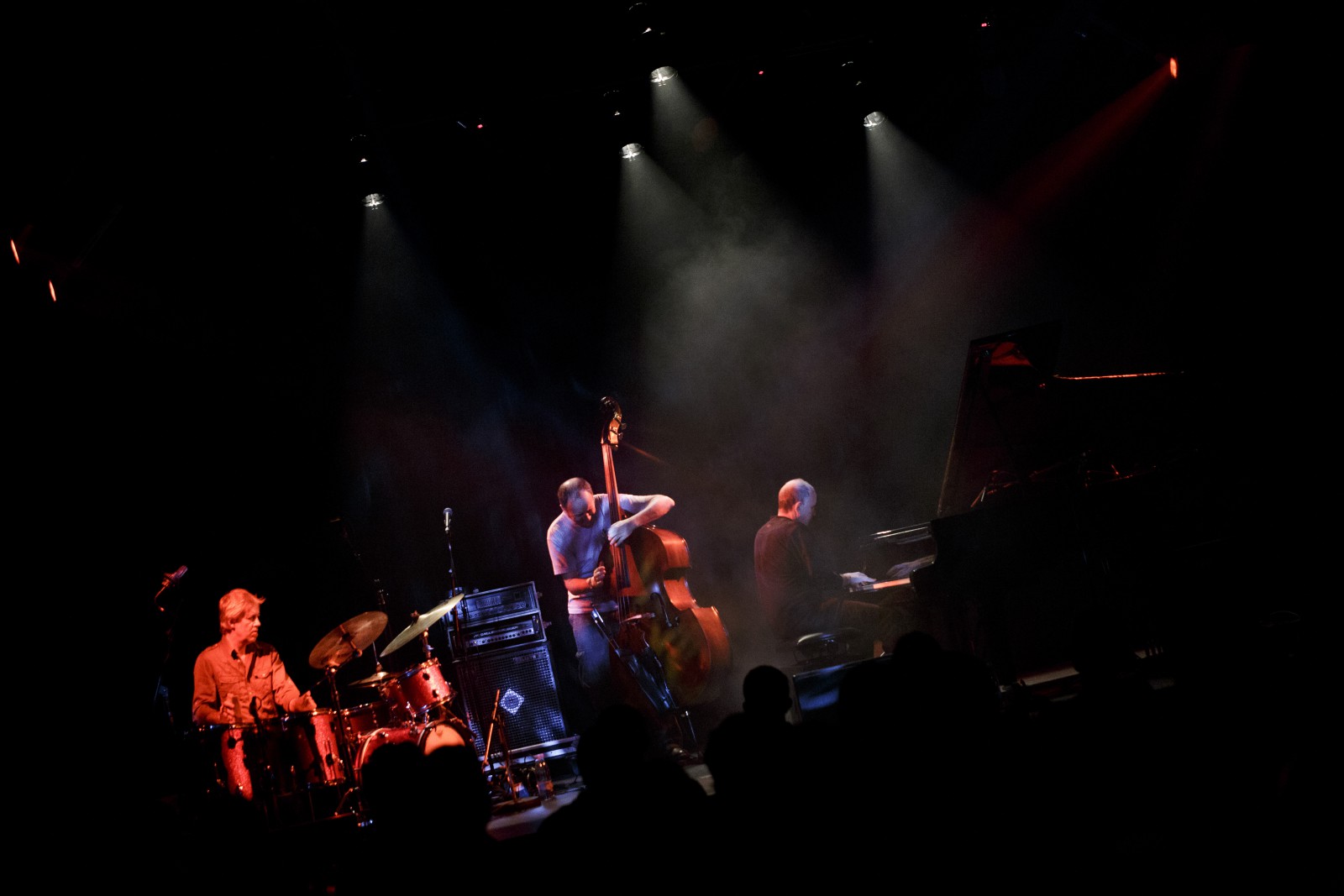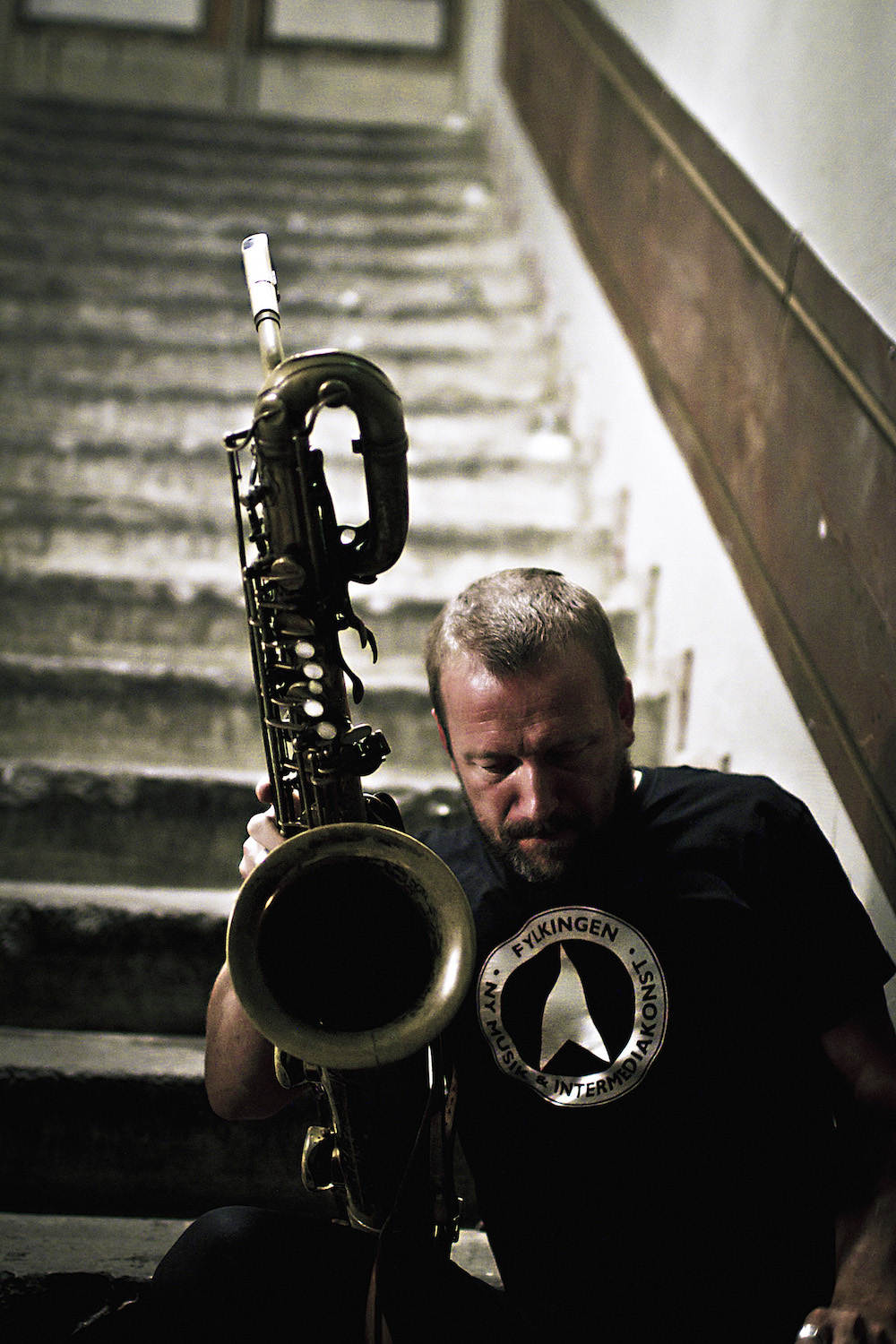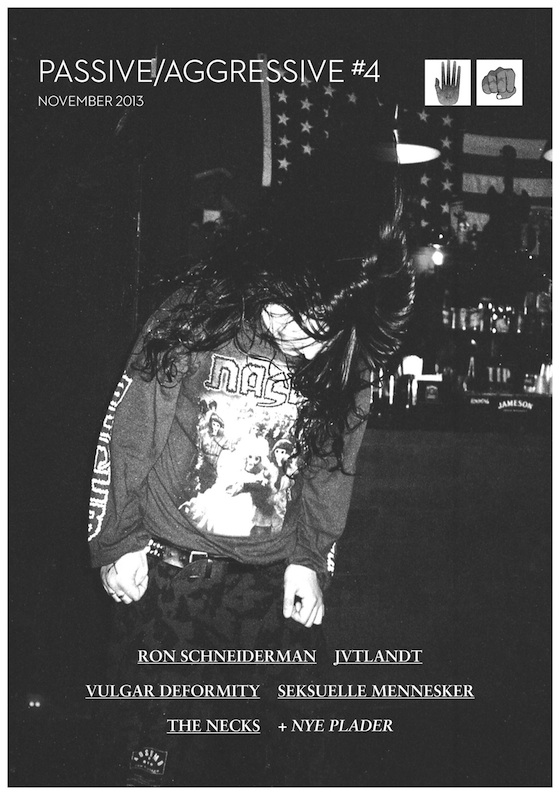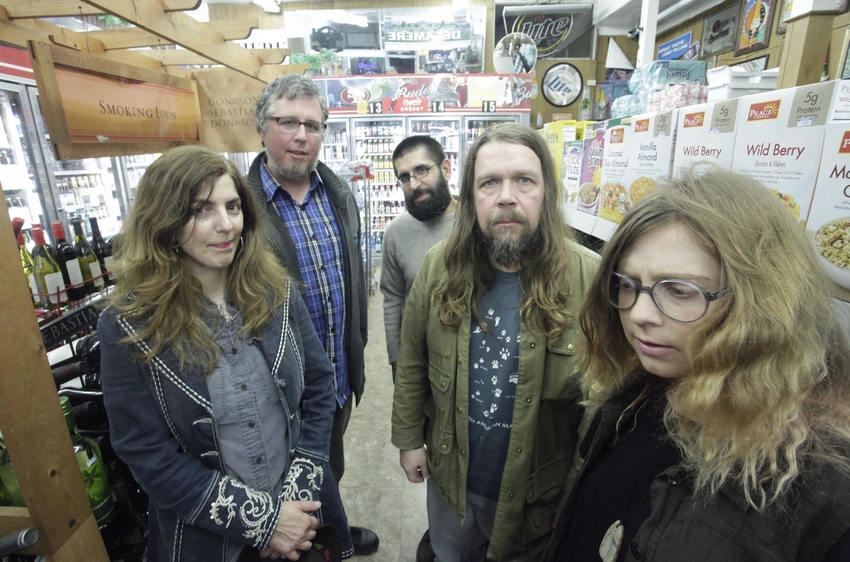The Necks – Et livsværk bliver til (interview med Chris Abrahams)

Australske The Necks har udfordret os ved at udsende timelange hypnotiske (eller dødkedelige?) improvisationer i et velkendt trioformat, der tager selvet ud og lade musikken tale. Efter 25 år holder Chris Abrahams, Tony Buck og Lloyd Swanton stadig fast i den samme metode, som med tiden former The Necks til et sjældent livsværk i konstant udvikling. Dette interview er lavet umiddelbart inden The Necks’ fantastiske album “Open” (2013, eget label) og er oprindeligt bragt i Passive/Aggressive ZINE #4.
Af Simon Christensen. Fotos: Kristoffer Juel Poulsen.
Historien kort: Trioen The Necks blev dannet i 1987 i Sydney. De udsendte deres første album, Sex, i 1989 og har siden udgivet 17 albums, heraf fire liveudgivelser og tre soundtracks. Musikken består af lange frie improvisationer, typisk af omkring en times varighed, og de er alle udgivet på cd, fordi de ikke passer til lp-formatet, bortset fra ”Mindset” fra 2011, der udkom både på cd og lp. Deres faste årlige turné om sommeren i Australien og årlige studiedage i Sydney bærer i sig selv et rituelt præg, og sådan har deres karriere gennem de sidste 25 år haft et konceptuelt strejf, selvom musikken i praksis er helt åben for indtryk. Chris Abrahams, Tony Buck og Lloyd Swanton har en baggrund i jazz og som studiemusikere for mere eller mindre tvivlsomme navne, men specielt Abrahams og Buck har en forbindelse til eksperimenterende musik i Japan og i Berlin, hvor de begge bor i perioder. På overfladen er udgangspunktet en helt klassisk jazztrio, men som improvisationsmusikere har de bevæget sig væk fra jazzen og ud mod trance, avantgarde og moderne minimalisme. De har som mål at opløse fornemmelsen af et selv og lade musikken opstå ud af, ja, hvad?
En forklaringsmodel til at forstå The Necks kunne være at drage en parallel til den japanske filminstruktør Yasujirō Ozu (1903-1963), der lavede alle sine film ud fra samme cinematografi – faste kamerapositioner i knæhøjde, store narrative ellipser, dramaer om familierelationer og årstiderne. Denne konsekvente fortællestil gav et indtryk af en karriere, der udfoldede alle hans film som ét langt sammenhængende værk. Et livsværk, der kræver et utroligt tålmod, og som man som kunstner kun får ét forsøg til at lave.
Making music accordingly
Chris Abrahams kigger frem helt nede i bunden af skærmen. Han er med på Skype fra et langtfra mondænt arbejdsværelse en sen aften i Sydney.
What do you expect from the crowd when you go tour, and how do you adapt to the different acoustics in the live-setup?
“The reputation of the band seems to be that in certain countries we are more popular, in UK and Australia we are quite well-known and played big stages outdoors. Which was something that we thought we might even be good at compared to playing indoors because the sound is different and you can hear the other stages. We can play all sorts of venues, we played in a small church in Austria all acoustic, or we can play All Tomorrow’s Parties outdoors through a PA. What we do is quite subordinate in that way. It’s hard to verbalize, but we approach it differently musically at the level of how we play. Our sound is very different, so we play differently. In many ways the thing about a band going into a stage and saying “the acoustics of this place is terrible” – that whole thing isn’t really relevant for The Necks. We tend to utilize the acoustic, the quality of the PA, the vibe coming off the audience in the way we play, and our music is more sounding up the environment we play in; making music accordingly. I think we play these places very differently, and it’s not like it’s any less performance to play one place than another.”
Can you touch upon a subject mentioned in an earlier interview, that your studio albums creates a binaural sensation, the feeling of being there live in the middle of the recording?
“We never actually made a binaural recording, and it must be a comment on a somewhat slightly other subject. I could argue that a stereo-mix of The Necks could be seen in relation to a live performance. In terms of the binaural I would think of something very heavily panned and use of microphones close to the listeners’ ears. The main difference between the stereo recordings and the live performance for The Necks is that we have always been very aware of this and treated it differently. You could say that we are two kinds of bands. When we walk out on stage to play live, we just let the music unravel in the way it’s gonna unravel – and we steer it, but the outcome isn’t really known because there is no over-arche-concept or editing process, except just playing it. Our studio albums seem to be quite static and would be a collection of scenes that happened over the course of an hour, but live we will be playing bigger build-ups. The recording of an organ in stereo or even in a six speaker-version is never gonna sound the same as sitting in front of an instrument with a thousand pipes at various places on a wall coming at you. We never really had a problem delineating that, we never tried to recreate that process of making studio albums even though we released actual live albums.”
Wait the way through
How much do you work on the studio albums after first recording? I consider them rather improvised too.
“It’s kinda changed. In the beginning we used magnetic tapes and only had 24 tracks, and we would record the basis one hour track and do some overdubs on it, and, over the course of ten days, add things and take things away before we mixed it, and the way we edited would be kind of chronological. On the last three-four albums we used digital, and now there are lots of more tracks on each recording, and we use field recordings, guitars, organ and half a dozen tracks with piano and a lot of drum tracks. And then we kind of just wait our way through making sense of it.”
How much are The Necks’ shows improvised, and what deals do you make regarding the direction before you go on stage?
“It’s a complex question because we don’t talk before a show. At no point do we ever discuss what’s gonna happen, what we are gonna play, or who’s gonna start. But I wouldn’t necessarily call this free improvisation because we have been doing this a long time and been playing together since we were teenagers. We just have a way of playing, and we always sound like The Necks. What we do is very recognisable. We have our method and a way of playing it. I don’t wanna say that we just go out and do the same thing over and over again, but in a sense we do.”
How do you make that choice in the moment? Is it an emotion or just your ears listening?
“There can be certain flashes of ‘this is the right thing to do’, but on a whole what I don’t wanna do is more informative. I don’t wanna be thinking fem minutes ahead, and sometimes I do, but then I wouldn’t say I was having a good time. That’s not what playing with The Necks is about. It’s not something verbal or not something rational. We aim to keep an open mind, and we do things that we don’t want, that we are moving away from, and we are communicating in a certain way through music, because we have been playing together for almost 30 years. You get somewhere just by doing stuff, and if you do it again and again, it will taking you places. All I really can say is that the music decides. And I know that, it sounds wishy-washy, but it’s as close as I can get. Things appear and cause you to follow them while we play. If one of us left The Necks, that would be the end of the group, because the whole thing is reliant to a shared understanding of what we do. There are times when I feel like I am playing something, but then I stop playing and realizing it wasn’t me playing that, so I don’t really feel 100 per cent in control of it.”
You have done 17 albums now, what is it you look back at?
“For me I really just enjoy playing and I see is as a privilege to go on stage for two hours with The Necks and have that experience. Taking out the live albums it comes down to 13 albums in 26 years. And when we go record an album it’s almost always after our yearly tour round Australia in the summer, so in many ways it feels like a distillation of the live performances of the tour with the possibility to add somethings in the studio, like my playing the organ, Tony playing the guitar or adding other recordings.”
Does a The Necks studio album need to sound different or have another idea than the one prior? Even if you use the same method in the proces.
“We have a broad concept but not from album to album. I think our albums sound a lot different actually. “Mindset” was much more aggressive than the new album which is much more spacious. Having said that I think we can go out and play a live show like we did in 1990. We hit a way upon doing things very early on. And rather than change stuff we just added to it, maybe especially in a rhytmic sense. In the past we tended to have a clearer interlocking polyrythmic approach whereas now its a much more multirythmic field with lot of autonomy and individual direction.”
A fairly important subject among the Danish experimental scene at the moment is the mediation of the music. With The Necks you seem to let the music talk, both in the sense that you don’t talk on stage, you make hour long tracks and very neutral art work and titles – but on the other hand you are very clear and give plenty of interviews and are keen on talking about your music, even if it is abstract. What is your view on letting your music talk?
“We tend to let the music speak. I would love to talk to the audience, but we were never good at it.”
A new infrastructure on the experimental music scene
In your experience, how is the condition for playing experimental or improvised music, and how did it change?
“In general there is a lot of activity. There are plenty of opportunities but not any money to play. For instance in Berlin (where Tony Buck lives, ed.) where people tend to go to. I think it is interesting times, you can buy equipment for around 100 euros and record an album yourself, but I don’t think that people go out to release an album to make money anymore, but it is almost a business card-approach to go out and make an album. Improvised music is something that can be made often and all over. The infrastructure doesn’t need to be that great, so I think there is a lot of it happening, and there seems to be an audience for it to spread around. Is that what you are going for?”
My impression is that there are lots of good music being made out there in Europe right now, I don’t know much about Australia or North America. So it’s good as long as you accept, you are not gonna make any money from it. I mean if you take music as an art form, not an industry, then that scene is really interesting right now.
“There are lot of stuff being released, a lot of touring, and also a lot of communication between people across countries. I agree with you, it’s very exciting.”
How would you describe the scene, where The Necks started out?
“Originally we came out of the 60’s dominated modern jazz scene in Sydney – inspired by John Coltrane, Miles Davis, Pharaoh Sanders, Archie Shepp. They were my idols and how I met Tony. We have known each other since we were teenagers and played together since maybe 1977, quite a long time before forming the band. But I am not sure if we still belong to that jazz scene in Australia. The formation of The Necks was about doing something different. Lloyd and I was in another group that disbanded and he called me up one day, if I wanted to start a trio with Tony. He said ‘what do you think about the name The Dogs’, and I said ‘what do you think about The Necks’. We found a rehearsing room and basically didn’t play for anyone the first eight months, really. I think the method of the group was formed already at this point after about three rehearsals. It was there straight away and we didn’t have to philosophize or conceptualize what is was. The first gig we got was a 16-gig tour of Mexico where we just backed a singer, and then Tony and I ended up going to Jamaica for a couple of weeks, which had a profound effect on my view on the way of music was being recorded and made. Since 25 years ago I went through a sort of soul music, reggae, funk and African-American music. And then I got into rock and indie rock music, and then I guess it changed when I moved to Berlin 15 years ago and the reductionist scene, but we’ve been through whatever since we started, progressive folk, freejazz and noise stuff. I don’t think you really can be into genres that much in this environment. Recently I thought about the effect on that way of starting a band. And even the first 10 years of the band we almost only played in one part of Australia. The evolution of the group has taken a long time, and I think it’s mirrored in the music we play that it kind of unfolded without us really having an idea or being aggressive about marketing. We never had a manager but just followed our noses and letting one thing lead to another. At that time I had been in some groups investing all kinds of emotional and intellectual energy into projects and then they kind of just evaporated. The Necks was just a therapeutic thing and a way of playing music that I haven’t experience before. And it kind of removed all the stress and the eager of it. It was the first time that I ever played music that I felt like I could listen to it while I was playing it.”
Info: The Necks vender tilbage til Jazzhouse mandag den 9. november, hvor de har givet koncert årligt siden 2012. Lyt til optagelsen Live in Jazzhouse 2013 i Sounds.



